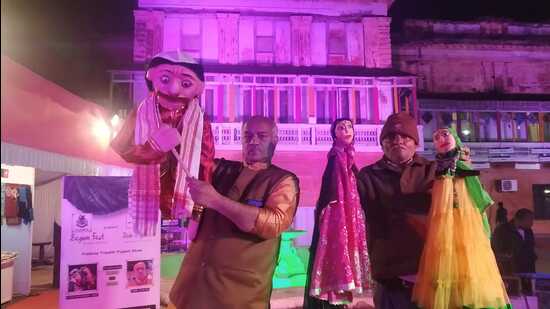Strings Attached: Age-old part of country’s folk heritage, puppetry hanging by a thread in Lucknow
Lucknow-based puppeteer Meraj Alam expounds that the real problem is the lack of opportunities to commercialise the puppetry art form.
LUCKNOW “I can’t abandon puppetry just because the art form is going out of style,” says Meraj Alam, a city-based puppeteer, actor, and sculptor. Despite a fast-reducing audience, Alam is quite comfortable clinging to the once-celebrated art of weaving stories by pulling the strings of inanimate objects.

Not many share his enthusiasm for the traditional source of infotainment though. Alam expounds that the real problem is the lack of opportunities to commercialise the puppetry art form. “Urdu slipped down the same slope. First, people stopped learning it, and then, it went out of trend. Slowly, movies and songs also reduced the usage of Urdu. Similarly, people don’t find the motivation to play an evangelist for puppetry today as there is very little money in it,” explained Alam.
Recalling his early days, Alam said, “I developed an interest in puppetry in 1997 as a student at Bhartendu Natya Akademi. I remember our professors telling us that theatre is a composite art form -- it can include music, dance, poetry, painting, sculpting, acting, and so much more. I always wondered how theatre had anything to do with sculpting. This was when my tryst with puppetry began.”
Tracing the glory days of puppetry in Uttar Pradesh, Alam, who was seen in Amitabh Bachchan-starrer Gulabo Sitabo, pointed out, “Such was the popularity of the art form that there used to be a locality called Putli Mohalla -- a colony with a predominant population of families involved in the business of crafting wooden dolls and puppets -- just a few miles away from Faizabad. However, the state only has a handful of half-hearted puppeteers left today. They, too, are pursuing the art form only as a hobby.”
Gulabo-Sitabo style of puppetry: Lucknow’s gift to the world
While the cultural history of the state is laden with references to puppetry, a sub-genre of the art form emerged at the court of Wajid Ali Shah, the last king of Awadh. In his court, two female puppet characters -- Gulabo and Sitabo -- were used to tell stories about social issues of the time by trading banters. This Gulabo-Sitabo style of glove puppetry has always caught the fancy of Lucknow.
For this style of puppetry, puppets were made out of papier mache or fabric and dressed in bright colours. This mode of entertainment was earlier performed on street corners and in the centre of localities where people would gather for viewing in groups. “This was most prevalent in the 70s and 80s,” said Pradeep Nath Tripathi, a 57-year-old puppeteer, who specialises in the rod puppetry style.
He added, “The traditional puppetry forms started to disappear from the 90s.” A Chowk resident, Tripathi remembers growing up watching puppeteers performing on the street. “They used to perform and beg for money or alms. Sometimes, they would get some grains and pulses from the viewers,” he recalled.
The puppeteers would commonly be accompanied by a dholak and manjira while performing. In Lucknow, these puppeteers would travel from town to town during festivals, performing for the locals. With time, however, and the advent of other forms of visual entertainment and media, puppetry as a form of amusement has largely died out. “Nowadays, people are more attracted to being on stage or in front of the camera for fame whereas puppetry is an art form that is performed largely behind the stage curtains,” said Tripathi.
He started his puppeteering career compering for Doordarshan, following which he got a fellowship from the Indian government to study puppetry for two years. According to him, people value the art form and conduct shows and conventions for puppetry outside of U.P. and India as well. “I have performed in Delhi, where we were paid in the range of ₹75,000-to- ₹90,000 for a 45-minute show. On the other hand, in U.P, one can hardly get more than ₹20,000. If each person on the team is paid just ₹1,500, and there are hardly two shows a year, how are they supposed to make a career out of it,” asked Tripathi. He says that the state culture department has not been able to provide any funds for puppeteers, however, some opportunities, although not nearly enough, are provided by the information department.






